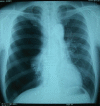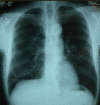Unilateral re-expansion pulmonary edema following treatment of pneumothorax with exceptionally massive sputum production, followed by circulatory collapse
- PMID: 20422058
- PMCID: PMC2866222
- DOI: 10.1155/2010/259195
Unilateral re-expansion pulmonary edema following treatment of pneumothorax with exceptionally massive sputum production, followed by circulatory collapse
Abstract
A case of a 61-year-old man who developed ipsilateral re-expansion pulmonary edema after pleural drainage for a right pneumothorax is described. The patient's chest x-ray revealed a totally collapsed right lung. After insertion of a chest drainage tube, he began to produce a moderate amount of serous, yellowish sputum. Despite continuous positive airway pressure support, his dyspnea gradually worsened and his oxygenation could not be maintained; therefore, to improve his hypoxemic state, intubation was necessary. His chest x-ray following chest tube insertion showed ipsilateral diffuse infiltrates. These radiographic and physical findings were consistent with re-expansion pulmonary edema. The present case was complicated by extreme hypotension and tachycardia due to massive fluid loss. His condition gradually improved with invasive mechanical ventilation. Re-expansion pulmonary edema is an uncommon complication of pleural drainage for pneumothorax, and therapy is supportive. In the present case, the exceptional severity of the pulmonary edema, as well as its general concept, is reviewed in accordance with other relevant literature.
Les auteurs décrivent le cas d’un homme de 61 ans qui a développé un œdème pulmonaire ipsilatéral de réexpansion après le drainage pleural d’un pneumothorax droit. La radiographie pulmonaire du patient a révélé un collapsus complet du poumon droit. Après l’insertion d’une sonde de drainage pulmonaire, il a commencé à produire une quantité modérée d’expectorations séreuses et jaunâtres. Malgré une pression positive continue, la dyspnée s’est graduellement aggravée, et on ne parvenait pas à maintenir son oxygénation. Il a donc fallu l’intuber pour améliorer son état hypoxémique. La radiographie pulmonaire suivant l’insertion de la sonde pulmonaire a révélé des infiltrats ipsalatéraux diffus. Ces observations radiographiques et physiques étayaient un œdème pulmonaire de réexpansion. Le présent cas était compliqué par une hypotension et une tachycardie extrêmes attribuables à une perte massive de liquide. L’état du patient s’est graduellement amélioré grâce à une ventilation mécanique effractive. L’œdème pulmonaire de réexpansion est une complication peu courante du drainage pleural d’un pneumothorax qui exige un traitement d’appoint. Dans le cas présent, la gravité exceptionnelle de l’œdème pulmonaire, de même que son concept général, est analysée conformément aux autres publications pertinentes.
Figures




Similar articles
-
Re-expansion pulmonary edema in a patient with total pneumothorax: a hazardous outcome.Gen Thorac Cardiovasc Surg. 2012 Sep;60(9):614-7. doi: 10.1007/s11748-012-0067-6. Epub 2012 May 25. Gen Thorac Cardiovasc Surg. 2012. PMID: 22627959 Review.
-
Unilateral pulmonary oedema due to lung re-expansion following pleurocentesis for spontaneous pneumothorax. The role of non-invasive continuous positive airway pressure ventilation.Int J Cardiol. 2007 Jan 18;114(3):398-400. doi: 10.1016/j.ijcard.2005.11.084. Epub 2006 Apr 3. Int J Cardiol. 2007. PMID: 16580755
-
Risk for re-expansion pulmonary edema following spontaneous pneumothorax.Surg Today. 2014 Oct;44(10):1823-7. doi: 10.1007/s00595-013-0726-y. Epub 2013 Sep 25. Surg Today. 2014. PMID: 24065192
-
[Re-expansion pulmonary edema as a complication of a spontaneous pneumothorax drainage--a case review].Rozhl Chir. 2008 Jul;87(7):347-51. Rozhl Chir. 2008. PMID: 18810926 Slovak.
-
An uncommon life-threatening complication after chest tube drainage of pneumothorax in the ED.Am J Emerg Med. 2004 Nov;22(7):615-9. doi: 10.1016/j.ajem.2004.09.005. Am J Emerg Med. 2004. PMID: 15666274 Review.
Cited by
-
Re-expansion pulmonary oedema - differential lung ventilation comes to the rescue.Indian J Anaesth. 2014 May;58(3):330-3. doi: 10.4103/0019-5049.135051. Indian J Anaesth. 2014. PMID: 25024481 Free PMC article.
-
Acute Hypoxemic Respiratory Failure after Large-Volume Thoracentesis. Mechanisms of Pleural Fluid Formation and Reexpansion Pulmonary Edema.Ann Am Thorac Soc. 2016 Mar;13(3):438-43. doi: 10.1513/AnnalsATS.201510-716CC. Ann Am Thorac Soc. 2016. PMID: 26963356 Free PMC article. No abstract available.
-
Re-expansion pulmonary edema in a patient with total pneumothorax: a hazardous outcome.Gen Thorac Cardiovasc Surg. 2012 Sep;60(9):614-7. doi: 10.1007/s11748-012-0067-6. Epub 2012 May 25. Gen Thorac Cardiovasc Surg. 2012. PMID: 22627959 Review.
-
Bilateral re-expansion pulmonary edema: an uncommon complication of the pneumothorax drainage.Arch Clin Cases. 2021 Oct 27;7(1):10-14. doi: 10.22551/2020.26.0701.10166. eCollection 2020. Arch Clin Cases. 2021. PMID: 34754921 Free PMC article.
-
Radiographically Severe but Clinically Mild Reexpansion Pulmonary Edema following Decompression of a Spontaneous Pneumothorax.Case Rep Pulmonol. 2014;2014:709560. doi: 10.1155/2014/709560. Epub 2014 Aug 3. Case Rep Pulmonol. 2014. PMID: 25165607 Free PMC article.
References
-
- Adegboye VO, Falade A, Osinusi Kobajimi MO. Reexpansion pulmonary oedema as a complication of pleural drainage. Niger Postgrad Med J. 2002;9:214–20. - PubMed
-
- Gordon AH, Grant GP, Kaul SK. Reexpansion pulmonary edema after resolution of tension pneumothorax in the contralateral lung of a previously lung injured patient. J Clin Anesth. 2004;16:289–92. - PubMed
-
- Sivrikoz MC, Tuncozgur B, Cekmen M, et al. The role of tissue reperfusion in the reexpansion injury of the lungs. Eur J Cardiothorac Surg. 2002;22:721–7. - PubMed
-
- DuBose J, Perciballi J, Timmer S, Kujawaski EJ. Bilateral reexpansion pulmonary edema after treatment of spontaneous pneumothorax. Curr Surg. 2004;61:376–9. - PubMed
-
- Carlson RI, Classen KL, Gollan F, Gobbel WG, Jr, Sherman DE, Christensen RO. Pulmonary edema following the rapid reexpansion of a totally collapsed lung due to a pneumothorax: A clinical and experimental study. Surg Forum. 1958;9:367–71. - PubMed
Publication types
MeSH terms
LinkOut - more resources
Full Text Sources
Medical

